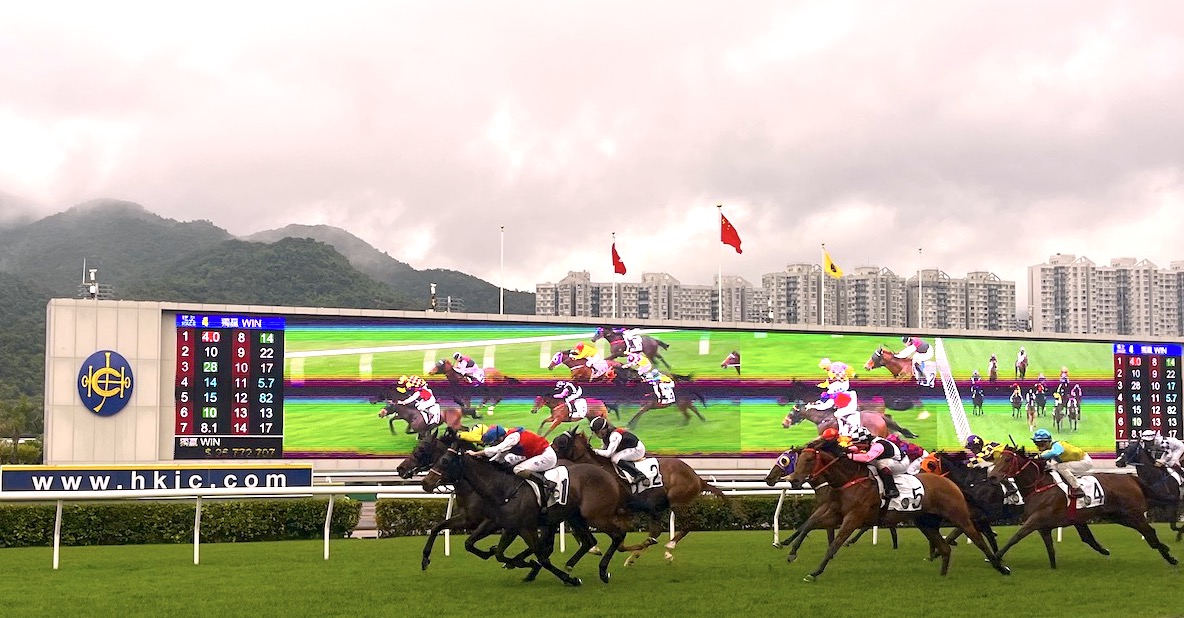If you’re thinking of visiting the World’s Coolest City, congratulations. It’s an amazing place that’s constantly buzzing with activity and excitement. You can reach Hong Kong from several Asian countries for under $100 USD. You could spend your whole trip exploring along Lockhart and Nathan Road shopping and dining. Nobody would blame you. But you’d be missing out if you didn’t spend at least part of your Sunday at Sha Tin Racecourse.
While attractions like the Big Buddha or Hong Kong Disneyland are popular with tourists, a day at the races is a uniquely local experience. Locals outnumber visitors by a wide margin and evidence of the sport’s popularity is obvious around the city with OTB’s in various neighborhoods and the racing press on every newsstand.
Need a Room? Search Hong Kong Hotels at Expedia or Booking.com.
In recent years the US thoroughbred industry has been contracting circuits into a smaller number of tracks. Outside of Kentucky, attendance is low with most fans and bettors enjoying the races via simulcast. For Americans coming to Hong Kong a visit to Sha Tin Racecourse might be their first exposure to horse racing. That’s all the more reason to go. What’s the point of travel if not to experience new things?

Where’s the Money? This site may contain affiliate links. Many travel sites include such links to earn a commission at no cost to readers.
Hong Kong’s Racing History
By the time the British took over control of Hong Kong, the UK had been promulgating thoroughbreds for around 150 years. The first football association in England was still more than 20 years away from its formation. Horse racing was the most popular sport in the world. When people said sporting, they meant racing.
When the British settled in the US, they brought horses with them. The various jockey clubs formed with stock descended from the original Royal Mares. The sport spread across the continent with several of the founding fathers keeping stables.The same was true in Hong Kong. Racing on the island began in 1841. A few years later the track at Happy Valley was constructed as a dedicated arena for racing.
While racing’s popularity has waxed and waned through the decades, it continues to grow steadily in Hong Kong, and Sha Tin Racecourse was built on land reclaimed from rice paddies in 1978.




Getting to Sha Tin Racecourse
Most hotels in Hong Kong are along one of two subway lines. The red line runs up the spine of Kowloon Side while the blue line traces the north shore of the island. The Admiralty station is right next to Central on the island side and is also a large interchange. Most visitors are going to find it easiest to take red or blue to admiralty and transfer to the east line there.
The usual thing is for Sha Tin Racecourse to hold events on Sunday with Happy Valley racing on Wednesday. On race days the east line (light blue) runs directly to the grandstand. You step off the platform and enter the racetrack from there. The trip shouldn’t take more than 30 minutes from your hotel on one of these lines.
Perhaps unique to Hong Kong, the taxi fleet and Uber drivers are one and the same. You can open Uber and get a taxi from your phone. But the trains are so efficient that shouldn’t be necessary.


Tickets to Sha Tin Racecourse
I had some difficulty entering Sha Tin Racecourse. In the US most tracks are free to enter on days without major graded stakes scheduled. If there’s a charge you just walk up to the box office and pay it, such as when you visit Churchill Downs.
There are no tickets or box office at Sha Tin Racecourse… but it’s not free either. For general admission you have to tap your Octopus card. You should obtain one of these as soon as you land at the airport even if you’re only staying a couple days in Hong Kong. I visited Sha Tin Racecourse on the morning of my first full day in town. I hadn’t yet acquired an Octopus and was stuck in between the subway and the racetrack gates until a kind employee took pity on me and swiped me in.
The only way to obtain an English language race program is from a vending machine with an Octopus. Even though I’m a fairly experienced horseplayer trying to make picks without past performances is nearly impossible. The racing analysis in the paddock is all in Chinese. No translations or subtitles. Without an English program you’re limited to what information you can glean on your phone from the Sha Tin Racecourse website and what you can see in the horses with your own eyeballs.
Beyond general admission both Hong Kong tracks sell memberships, and tourists can pay $130 HKD ($16.60 USD) to access the members area. An extra six dollars isn’t a lot but you get to see quite a bit just with general admission.

Enjoying a Day at the Races
Hong Kong is known for a prestigious racing culture. High quality horses run in full fields for generous purses. Fans worldwide follow the graded stakes races from Hong Kong. If you come to either Sha Tin Racecourse or Happy Valley it’ll be evident even with the language barrier that this is not a bunch of nags running at the state fair.
Turf racing is considered the most formful in the US and the turf course at Sha Tin is wide and gorgeous. Most races are on grass while the all-weather (synthetic dirt) track is smaller, running inside the turf oval. It’s hard to tell if you’ve never been to a track before but the quality of the horses and the dedication of the horsemen is top notch. Sitting in the paddock area feels like attending an equestrian event at the Olympics.
The view into the mountains over a beautifully landscaped course is breathtaking. There’s no neglect or deferred maintenance such as you’d find at many US tracks. Like everything else in Hong Kong the scenery reminds you of your own small stature. It’s a place where everything else is on the scale of mountains and skyscrapers reaching into the clouds.
You’ll need cash to bet. It’s easy to feel like a high roller when you’re laying $50 HKD on each race. But that’s only around $6 US. Even if you enjoy thoroughbred racing it can be hard to get into betting seriously on the track. With the language barrier and the novelty of it all, most of the fun I had was exploring the massive facility and taking it all in.
















